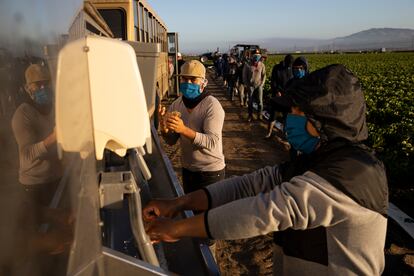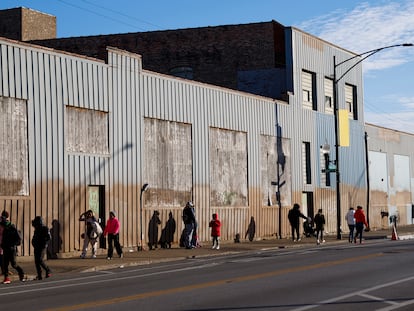The United States will need 7 million migrants to cover old age support programs for baby boomers
The country’s aging population and low fertility rate jeopardizes the solvency of Social Security and the Medicare program, according to a new study by Brookings


The immigration crisis has become a recurring theme in social gatherings and political debates, and is the main issue of the U.S. presidential election. Amid this discussion, one certainty stands out: while it’s well known that migrants have a need to live in the United States, a study has highlighted that the country needs them too.
Twenty percent of U.S. workers were not born in the United States, and it is expected that in the near future more than seven million more migrants will be needed for the labor market. That’s according to a study by Brookings, which warns about how the higher-than-expected increase in pensioners following the Covid-19 pandemic will affect the U.S. economy.
As the baby boomer generation approaches age 80, two challenges are facing the U.S. economy: providing staff to care for the elderly and ensuring the solvency of Social Security and the Medicare program.

“There are going to be many more people over 90 and over 100, and although they are in better health than in the past, they will need support and care. We have a challenge because the ratio between people of working age and older people is going to be lower,” said Tara Watson, director of the Brookings Center for Economic Security, in a conference on the economy and immigration policy.
In addition to an aging population, the U.S. also faces a plummeting fertility rate, which is currently around 1.7 births per woman. Thus, if in 1970 there were 5.7 people of working age — between 18 and 64 years old — for every person over 65 years old; in 2020, there were 3.7 workers, and by 2040 there are expected to be only 2.7. “Migrants are not going to solve the problem of Social Security solvency, but they can help,” Watson argues.
More than seven million migrants will be needed to address these issues. This figure is reached based on the current participation of migrants in the labor market and the positions that will remain vacant due to retirement in the coming years, as outlined in the Brookings report. According to the study, the areas where there will be the biggest demand for work visas will be in production and manual work, with 2.87 million positions needed to be filled. The retail sales and entertainment services sector will be the second most in demand, with 2.15 million vacancies, followed by health and care services, with just over one million.
More demand from California, Texas and New York
U.S. states where migrants already make up a large part of the working population, such as California, Texas and New York, will have a greater demand for visas. Demand is also expected to be high in New Jersey and Illinois, despite the fact that their labor markets have lower forecast growth. Meanwhile, states such as Utah and Tennessee, which have a lower participation of migrants, will need more labor due to the expected growth in their labor markets.
To meet these needs, the report recommends expanding work visas for migrants working in agriculture, approving more asylum applications, and creating a state visa program.
The crisis caused by the mass arrival of migrants at the U.S.-Mexico border unleashed a wave of criticism against U.S. President Joe Biden, who has failed to reach a bipartisan agreement on border security. The objections of Donald Trump, the presumptive Republican presidential candidate, have stopped a deal being struck with the Republicans in Congress. In response, Biden signed an executive order to shut down asylum requests at the U.S.-Mexico border once the average number of unauthorized crossings hits 2,500 between ports of entry, a number which has surged during his presidency.

While the arrival of migrants is seen with concern in the U.S., Madeline Zavodny, a professor of Economics specialized in Immigration at the University of North Florida, assures that “when they arrive, migrants not only work, they also buy things, increase the labor demand, they are creating jobs.” Zavodny explains that migrants also tend to settle in less populated areas, often rural, where labor is needed. “They fill gaps in the labor market, at low, medium or high level, such as teachers, scientists... and they are very entrepreneurial, from a modest business to a high level executive, like Elon Musk,” she adds.
This economist argues that the U.S. market has space for more migrants who, contrary to popular opinion, are not threatening Americans’ jobs, but rather fulfilling complementing roles. “The U.S. economy can absorb a very large number of migrants, even the flows that we have seen in the last year and a half […] Since 1990, the number of migrants who can arrive legally is fixed, even though the size of our economy has more than doubled. We are not meeting the economic needs and part of what we see at the border is exacerbated by the fact that we do not have the appropriate legal pathways,” she points out.
Ahead of the November 5 election, immigration has become the main rallying call of the Republican Party, which has accused the Biden administration of being too soft on border control. “Voters are concerned about illegal immigration because of the disorderly and chaotic situation at the border. We can’t sell the public on trusting us [...], that in the long run it’s going to benefit us, that they shouldn’t worry. That those who oppose it are racists and xenophobes. It’s not true. Ordinary people, ordinary voters, particularly working class voters, are very worried,” says Ruy Teixeira, a political scientist at the American Enterprise Institute

The concern is greater in the U.S. states that receive a higher number of migrants. While the federal government collects the taxes paid by migrants, local and state governments face the cost of providing services to the mass arrivals. “Part of the federal government’s resources should be redirected to places that are absorbing migrants with less education, which are the ones that have a higher fiscal cost. In the long term, the federal government continues to win, but in the short term, states and local governments face expenses for which they do not have the budget,” says Watson.
Labor rights
Meanwhile, the federal government announced measures this week to support migrant labor rights. The Department of Labor’s migrantworker.gov website will now be available in six more languages, instead of just English and Spanish. Created in August 2023, the website has a Q&A format and will now be available in Arabic, Chinese, Creole, Portuguese, Tagalog and Vietnamese. New videos have also been added with guidance for women, with information on how women can stay stage while breastfeeding. This is an addition to the pre-existing videos on issues such as work breaks, salaries and precautions to take in extreme heat.
Sign up for our weekly newsletter to get more English-language news coverage from EL PAÍS USA Edition
Tu suscripción se está usando en otro dispositivo
¿Quieres añadir otro usuario a tu suscripción?
Si continúas leyendo en este dispositivo, no se podrá leer en el otro.
FlechaTu suscripción se está usando en otro dispositivo y solo puedes acceder a EL PAÍS desde un dispositivo a la vez.
Si quieres compartir tu cuenta, cambia tu suscripción a la modalidad Premium, así podrás añadir otro usuario. Cada uno accederá con su propia cuenta de email, lo que os permitirá personalizar vuestra experiencia en EL PAÍS.
¿Tienes una suscripción de empresa? Accede aquí para contratar más cuentas.
En el caso de no saber quién está usando tu cuenta, te recomendamos cambiar tu contraseña aquí.
Si decides continuar compartiendo tu cuenta, este mensaje se mostrará en tu dispositivo y en el de la otra persona que está usando tu cuenta de forma indefinida, afectando a tu experiencia de lectura. Puedes consultar aquí los términos y condiciones de la suscripción digital.
More information
Archived In
Últimas noticias
Most viewed
- Sinaloa Cartel war is taking its toll on Los Chapitos
- Reinhard Genzel, Nobel laureate in physics: ‘One-minute videos will never give you the truth’
- Oona Chaplin: ‘I told James Cameron that I was living in a treehouse and starting a permaculture project with a friend’
- Why the price of coffee has skyrocketed: from Brazilian plantations to specialty coffee houses
- David King, chemist: ‘There are scientists studying how to cool the planet; nobody should stop these experiments from happening’










































